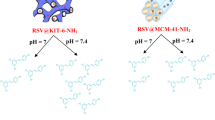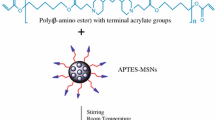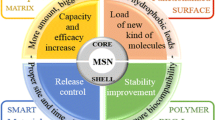Abstract
Ordered mesoporous silica materials exhibit potential features to be used as controlled drug delivery systems, including biocompatibility, textural and structural properties. In this paper, ordered mesoporous materials SBA-15, SBA-16 and MCM-41, which present different morphologies, pore sizes and array of mesopores (2D hexagonal, 3D cubic and 2D hexagonal, respectively), were synthesized, functionalized with folic acid by post-synthesis grafting and loaded with the anticancer agent methotrexate. The drug loading and its release kinetics profile were compared between all materials. The mesoporous silicas were characterized through thermogravimetric analysis, CHN elemental analysis, Fourier transform infrared spectroscopy, small-angle X-ray scattering, N2 adsorption, zeta potential, scanning electron microscopy and transmission electron microscopy in order to evaluate their physical–chemical properties. The interactions between methotrexate and the materials’ surface were systematically evaluated using X-ray photoelectron spectroscopy. The results showed the drug release kinetic might be controlled by the synthesis procedure and the degree of surface functionalization of the mesoporous silica.
Graphical Abstract













Similar content being viewed by others
References
Safari J, Zarnegar Z (2014) Advanced drug delivery systems: nanotechnology of health design A review. J Saudi Chem Soc 18:85–99. doi:10.1016/j.jscs.2012.12.009
Yang P, Gai S, Lin J (2012) Functionalized mesoporous silica materials for controlled drug delivery. Chem Soc Rev 41:3679–3698. doi:10.1039/c2cs15308d
Slowing II, Vivero-Escoto JL, Wu C-W, Lin VS-Y (2008) Mesoporous silica nanoparticles as controlled release drug delivery and gene transfection carriers. Adv Drug Deliv Rev 60:1278–1288. doi:10.1016/j.addr.2008.03.012
Kwon S, Singh RK, Perez RA et al (2013) Silica-based mesoporous nanoparticles for controlled drug delivery. J Tissue Eng 4:2041731413503357. doi:10.1177/2041731413503357
Mamaeva V, Sahlgren C, Lindén M (2013) Mesoporous silica nanoparticles in medicine—recent advances. Adv Drug Deliv Rev 65:689–702. doi:10.1016/j.addr.2012.07.018
Wang S (2009) Ordered mesoporous materials for drug delivery. Microporous Mesoporous Mater 117:1–9. doi:10.1016/j.micromeso.2008.07.002
Roggers R, Kanvinde S, Boonsith S, Oupický D (2014) The practicality of mesoporous silica nanoparticles as drug delivery devices and progress toward this goal. AAPS PharmSciTech 15:1163–1171. doi:10.1208/s12249-014-0142-7
Moritz M, Geszke-Moritz M (2015) Mesoporous materials as multifunctional tools in biosciences: principles and applications. Mater Sci Eng C 49:114–151. doi:10.1016/j.msec.2014.12.079
Moritz M, Łaniecki M (2011) Modified SBA-15 as the carrier for metoprolol and papaverine: adsorption and release study. J Solid State Chem 184:1761–1767. doi:10.1016/j.jssc.2011.05.015
Andrade GF, Soares DCF, Almeida RKDS, Sousa EMB (2012) Mesoporous silica SBA-16 functionalized with alkoxysilane groups: preparation, characterization, and release profile study. J Nanomater 2012:1–10. doi:10.1155/2012/816496
Doadrio JC, Sousa EMB, Izquierdo-Barba I et al (2006) Functionalization of mesoporous materials with long alkyl chains as a strategy for controlling drug delivery pattern. J Mater Chem 16:462. doi:10.1039/b510101h
Alexa IF, Pastravanu CG, Ignat M, Popovici E (2013) A comparative study on long-term MTX controlled release from intercalated nanocomposites for nanomedicine applications. Colloids Surf B Biointerfaces 106:135–139. doi:10.1016/j.colsurfb.2013.01.022
Pang J, Zhao L, Zhang L et al (2013) Folate-conjugated hybrid SBA-15 particles for targeted anticancer drug delivery. J Colloid Interface Sci 395:31–39
Thomas MJK, Slipper I, Walunj A et al (2010) Inclusion of poorly soluble drugs in highly ordered mesoporous silica nanoparticles. Int J Pharm 387:272–277. doi:10.1016/j.ijpharm.2009.12.023
Treccani L, Yvonne Klein T, Meder F et al (2013) Functionalized ceramics for biomedical, biotechnological and environmental applications. Acta Biomater 9:7115–7150. doi:10.1016/j.actbio.2013.03.036
Knežević NŽ, Durand J-O (2015) Targeted treatment of cancer with nanotherapeutics based on mesoporous silica nanoparticles. ChemPlusChem 80:26–36. doi:10.1002/cplu.201402369
Sudimack J, Lee RJ (2000) Targeted drug delivery via the folate receptor. Adv Drug Deliv Rev 41:147–162. doi:10.1016/S0169-409X(99)00062-9
Fan J, Fang G, Wang X et al (2011) Targeted anticancer prodrug with mesoporous silica nanoparticles as vehicles. Nanotechnology 22:455102. doi:10.1088/0957-4484/22/45/455102
Rosenholm JM, Meinander A, Peuhu E et al (2009) Targeting of porous hybrid silica nanoparticles to cancer cells. ACS Nano 3:197–206. doi:10.1021/nn800781r
Lu J, Li Z, Zink JI, Tamanoi F (2012) In vivo tumor suppression efficacy of mesoporous silica nanoparticles-based drug-delivery system: enhanced efficacy by folate modification. Nanomedicine 8:212–220. doi:10.1016/j.nano.2011.06.002
Lu Y, Low PS (2012) Folate-mediated delivery of macromolecular anticancer therapeutic agents. Adv Drug Deliv Rev 64:342–352. doi:10.1016/j.addr.2012.09.020
Pang J, Zhao L, Zhang L et al (2013) Folate-conjugated hybrid SBA-15 particles for targeted anticancer drug delivery. J Colloid Interface Sci 395:31–39. doi:10.1016/j.jcis.2012.12.016
Nzila A, Okombo J, Becker RP et al (2010) Anticancer agents against malaria: time to revisit? Trends Parasitol 26:125–129. doi:10.1016/j.pt.2009.12.002
Kozub P, Simaljakova M (2011) Systemic therapy of psoriasis: methotrexate. Bratisl Lek Listy 112:390–394
Vadia N, Rajput S (2012) Study on formulation variables of methotrexate loaded mesoporous MCM-41 nanoparticles for dissolution enhancement. Eur J Pharm Sci 45:8–18. doi:10.1016/j.ejps.2011.10.016
Barberá A, Lorenzo N, Domínguez C (2012) Current treatment of rheumatoid arthritis. Perspectives for the development of antigen-specific therapies. Biotecnología Aplicada 29:146–154
Zhao D (1998) Triblock copolymer syntheses of mesoporous silica with periodic 50 to 300 angstrom pores. Science 279:548–552. doi:10.1126/science.279.5350.548
Zhao D, Huo Q, Feng J et al (1998) Nonionic triblock and star diblock copolymer and oligomeric surfactant syntheses of highly ordered, hydrothermally stable, mesoporous silica structures. J Am Chem Soc 7863:6024–6036
Slowing II, Vivero-Escoto JL, Trewyn BG, Lin VS-Y (2010) Mesoporous silica nanoparticles: structural design and applications. J Mater Chem 20:7924. doi:10.1039/c0jm00554a
Smith JL, Herman RG, Terenna CR et al (2004) Sorption of nitrogen bases and XPS study of mesoporous solid acid SBA-15. J Phys Chem A 108:39–46. doi:10.1021/jp0305990
Hernández-Morales V, Nava R, Acosta-Silva YJ et al (2012) Adsorption of lead (II) on SBA-15 mesoporous molecular sieve functionalized with -NH2 groups. Microporous Mesoporous Mater 160:133–142. doi:10.1016/j.micromeso.2012.05.004
Ferraris S, Perero S, Vern E et al (2011) Surface functionalization of Ag–nanoclusters–silica composite films for biosensing. Mater Chem Phys 130:1307–1316. doi:10.1016/j.matchemphys.2011.09.019
Zhao X, Lu G, Hu X (2000) Characterization of the structural and surface properties of chemically modified MCM-41 material. Microporous Mesoporous Mater 41:37–47. doi:10.1016/S1387-1811(00)00262-6
Vrancken K, Possemiers K, Van Der Voort P, Vansant E (1995) Surface modification of silica gels with aminoorganosilanes. Colloids Surf A Physicochem Eng Asp 98:235–241. doi:10.1016/0927-7757(95)03119-X
Hanu LG, Hanu AM, Popovici E, Timpu D (2004) Nanosiliceous matrix for drug incapsulation. Romanian J Phys 49:817–822
Andersson J, Rosenholm J, Areva S, Lindén M (2004) Influences of material characteristics on ibuprofen drug loading and release profiles from ordered micro- and mesoporous silica matrices. Chem Mater 16:4160–4167. doi:10.1021/cm0401490
Balas F, Manzano M, Horcajada P, Vallet-Regi M (2006) Confinement and controlled release of bisphosphonates on ordered mesoporous silica-based materials. J Am Chem Soc 128:8116–8117. doi:10.1021/ja062286z
Qu F, Zhu G, Lin H et al (2006) A controlled release of ibuprofen by systematically tailoring the morphology of mesoporous silica materials. J Solid State Chem 179:2027–2035. doi:10.1016/j.jssc.2006.04.002
De Sousa A, de Souza KC, Leite PM da S, et al (2014) A dual-functional [SBA-15/Fe3O4/P(N-iPAAm)] hybrid system as a potential nanoplatform for biomedical application. doi:10.1039/c2ce25395j
Kleitz F, Kim TW, Ryoo R (2006) Phase domain of the cubic Im3−m mesoporous silica in the EO 106PO70EO106-butanol-H2O system. Langmuir 22:440–445. doi:10.1021/la052047+
Andrade GF, Soares DCF, dos Santos RG, Sousa EMB (2013) Mesoporous silica SBA-16 nanoparticles: synthesis, physicochemical characterization, release profile, and in vitro cytocompatibility studies. Microporous Mesoporous Mater 168:102–110. doi:10.1016/j.micromeso.2012.09.034
Kim JM, Chang SM, Kong SM et al (2009) Control of hydroxyl group content in silica particle synthesized by the sol-precipitation process. Ceram Int 35:1015–1019. doi:10.1016/j.ceramint.2008.04.011
Jaroniec C, Gilpin R, Jaroniec M (1997) Adsorption and thermogravimetric studies of silica-based amide bonded phases. J Phys 44242:6861–6866. doi:10.1021/jp964002a
Vora A, Riga A, Dollimore D, Alexander KS (2002) Thermal stability of folic acid. Thermochim Acta 392–393:209–220. doi:10.1016/S0040-6031(02)00103-X
El-Wahed MGA, Refat MS, El-Megharbel SM (2008) Synthesis, spectroscopic and thermal characterization of some transition metal complexes of folic acid. Spectrochim Acta Part A Mol Biomol Spectrosc 70:916–922. doi:10.1016/j.saa.2007.10.008
Stuart B (2004) Infrared spectroscopy: fundamentals and applications. Wiley, Sydney
Sing KSW (1985) Reporting physisorption data for gas/solid systems with special reference to the determination of surface area and porosity (recommendations 1984). Pure Appl Chem 57:603–619. doi:10.1351/pac198557040603
Kruk M, Jaroniec M (2001) Gas adsorption characterization of ordered organic–inorganic nanocomposite materials. Chem Mater 13:3169–3183. doi:10.1021/cm0101069
Sakamoto Y, Kaneda M, Terasaki O et al (2000) Direct imaging of the pores and cages of three-dimensional mesoporous materials. Nature 408:449–453. doi:10.1038/35044040
Beck JS, Vartuli JC, Roth WJ et al (1992) A new family of mesoporous molecular sieves prepared with liquid crystal templates. J Am Chem Soc. doi:10.1021/ja00053a020
Kaliaguine S (1996) Serge Kaliaguine D6partement de g6nie chimique, Universit~Laval, Ste-Foy, Qu6bec, G1K 7P4, Canada 1. 102:191–230
Ambrogi V, Donnadio A, Pietrella D et al (2014) Chitosan films containing mesoporous SBA-15 supported silver nanoparticles for wound dressing. J Mater Chem B 2:6054. doi:10.1039/C4TB00927D
Lindberg B, Maripuu R, Siegbahn K et al (1983) ESCA Studies of heparinized and related surfaces. J Colloid Interface Sci 95:308–321. doi:10.1016/0021-9797(83)90190-X
Kallury KMR, Macdonald PM, Thompson M (1994) Effect of surface water and base catalysis on the silanization of silica by (aminopropyl) alkoxysilanes studied by X-ray photoelectron spectroscopy and 13C cross-polarization/magic angle spinning nuclear magnetic resonance. Langmuir 10:492–499
Manzano M, Aina V, Areán CO et al (2008) Studies on MCM-41 mesoporous silica for drug delivery: effect of particle morphology and amine functionalization. Chem Eng J 137:30–37. doi:10.1016/j.cej.2007.07.078
Korsmeyer RW, Gurny R, Doelker E et al (1983) Mechanisms of solute release from porous hydrophilic polymers. Int J Pharm 15:25–35. doi:10.1016/0378-5173(83)90064-9
Costa P, Sousa Lobo JM (2001) Modeling and comparison of dissolution profiles. Eur J Pharm Sci 13:123–133. doi:10.1016/S0928-0987(01)00095-1
Kumar S, Singh AK, Prajapati SK, Singh VK (2012) Formulation and evaluation of once daily sustained release matrix tablets of aceclofenac using natural gums. J Drug Deliv Ther 2:16–24
Horcajada P, Rámila A, Pérez-Pariente J, Vallet-Regí M (2004) Influence of pore size of MCM-41 matrices on drug delivery rate. Microporous Mesoporous Mater 68:105–109. doi:10.1016/j.micromeso.2003.12.012
Izquierdo-Barba I, Sousa E, Doadrio JC et al (2009) Influence of mesoporous structure type on the controlled delivery of drugs: release of ibuprofen from MCM-48, SBA-15 and functionalized SBA-15. J Sol Gel Sci Technol 50:421–429. doi:10.1007/s10971-009-1932-3
Acknowledgments
The authors would like to thank FAPEMIG (Fundação de Amparo à Pesquisa do Estado de Minas Gerais), CAPES (Coordenação de Aperfeiçoamento de Pessoal de Nível Superior) and CNPq (Conselho Nacional de Desenvolvimento Científico e Tecnológico) for all financial support, and the Microscopy Center of the Federal University of Minas Gerais, Belo Horizonte, Brazil (http://www.microscopia.ufmg.br).
Author information
Authors and Affiliations
Corresponding author
Rights and permissions
About this article
Cite this article
Freitas, L.B.O., Bravo, I.J.G., Macedo, W.A.A. et al. Mesoporous silica materials functionalized with folic acid: preparation, characterization and release profile study with methotrexate. J Sol-Gel Sci Technol 77, 186–204 (2016). https://doi.org/10.1007/s10971-015-3844-8
Received:
Accepted:
Published:
Issue Date:
DOI: https://doi.org/10.1007/s10971-015-3844-8




